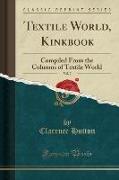- Start
- Textile World, Kinkbook, Vol. 7
Textile World, Kinkbook, Vol. 7
Angebote / Angebote:
Excerpt from Textile World, Kinkbook, Vol. 7: Compiled From the Columns of Textile World
Will you please inform me whether it is considered better to put a large number of ends on a section beam in the warping process, or whether a small number of ends on a beam is more desirable? (4811) The count or size of the yarn is an important factor in de ciding the number of ends to run on a beam. With fine yarns a greater number of ends may be placed side by 'side than with coarse yarns, and what would be considered a large number for a coarse yarn might be normal for a finer yarn. Looking at the question as a request for information as to the advantages and disadvantages of putting the largest num ber of ends practicable on a beam, as compared with the policy of putting as few ends as practicable on it, we might reply as follows: If a large number of ends are put on a beam they will lie too close to each other and after the yarn has gone through the size box on the slasher they will not part so readily as when there are fewer ends on the beam. This is especially true if four or five ends from the same beam have to be put in one dent in the front comb. If too small a number of ends are run they will make a ridgy beam. When the end is on the high part of the ridge it will run Off slack, when it is on the low part of the ridge it will run tight and is likely to break quite often during the running of the set.
It has been found that it is better to run more section beams with fewer ends per beam on a slasher, as it will give the warp a better chance to separate, which will make it run better in the loom. There should be just enough ends on the beam to make it smooth and level and not ridgy.
About the Publisher
Forgotten Books publishes hundreds of thousands of rare and classic books. Find more at www.forgottenbooks.com
This book is a reproduction of an important historical work. Forgotten Books uses state-of-the-art technology to digitally reconstruct the work, preserving the original format whilst repairing imperfections present in the aged copy. In rare cases, an imperfection in the original, such as a blemish or missing page, may be replicated in our edition. We do, however, repair the vast majority of imperfections successfully, any imperfections that remain are intentionally left to preserve the state of such historical works.
Folgt in ca. 5 Arbeitstagen
